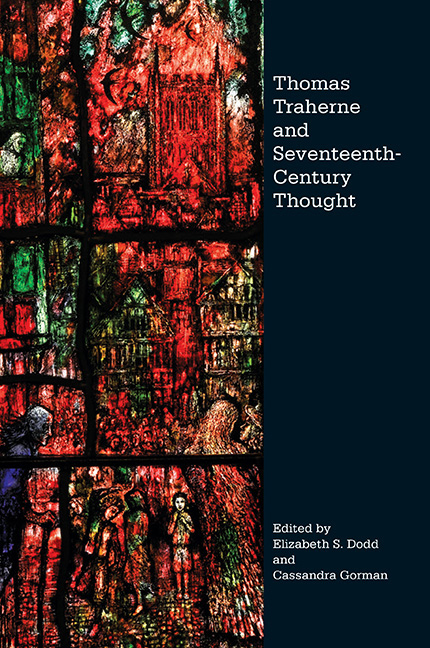Book contents
- Frontmatter
- Contents
- Contributors
- Acknowledgements
- Conventions and Abbreviations
- Foreword
- Introduction: ‘A lover of all Things … An Active ey’ (Select Meditations I.82): Traherne in Context
- PART I PHILOSOPHIES OF MATTER AND SPIRIT
- PART II PRACTICAL AND PUBLIC DEVOTION
- Afterword by Jacob Blevins
- Chronology of Traherne's Life and Contemporary Intellectual Developments
- Bibliography
- Index
- Index of Biblical References
- Studies in Renaissance Literature
Afterword by Jacob Blevins
Published online by Cambridge University Press: 05 July 2016
- Frontmatter
- Contents
- Contributors
- Acknowledgements
- Conventions and Abbreviations
- Foreword
- Introduction: ‘A lover of all Things … An Active ey’ (Select Meditations I.82): Traherne in Context
- PART I PHILOSOPHIES OF MATTER AND SPIRIT
- PART II PRACTICAL AND PUBLIC DEVOTION
- Afterword by Jacob Blevins
- Chronology of Traherne's Life and Contemporary Intellectual Developments
- Bibliography
- Index
- Index of Biblical References
- Studies in Renaissance Literature
Summary
Nearly 120 years after he was rediscovered and reintroduced to the world by Bertram Dobell, Thomas Traherne still fascinates us. When his poems and centuries re-emerged at the turn of the twentieth century, there was an explicit attempt by scholars to find a place for this new voice that had been pulled from the dusty shelves of the forgotten. Traherne's centuries and poems offered readers a strikingly personal series of meditations on the spiritual growth of an individual: there was the celebration of childhood, of nature, of happiness, of God, and of humankind itself; it was a poetic and theological voice that seemed out of place, or without place, upon initial reading. Scholars just did not know exactly what to do with it.
Much of the early scholarship on Traherne tried to find ‘the place’ for his work. There were attempts to define him as a proto-Romantic, hearkening toward writers like Wordsworth, Emerson, Whitman and Blake. He was also viewed as the poetic representation of a new Platonism, one corresponding with a group of Cambridge thinkers, including Benjamin Whichcote, Henry More and Ralph Cudworth, amongst others. He was a mystic, part of a long tradition of mystical interaction with nature and Godhead. He was perhaps a metaphysical poet, one whose voice belonged in the tradition of Donne, Herbert and Vaughan. For years, scholars tried to situate this voice somewhere, in some tradition, to find a literary, intellectual, and theological place from which to begin understanding the relevance of Traherne's work. However, there were also others who did not even try. Traherne could be read and understood in a spiritual vacuum, a writer who simply provided a kind of inspiration and model for living a moral life and celebrating the beauty of creation, all creation; a man of God who was testifying right in front of us, there on the page.
Despite important contributions from numerous early scholars, none of these approaches was wholly satisfying. Traherne did sound different than other seventeenth-century writers, but there were also substantial echoes of much else that we had read or felt before in other places.
- Type
- Chapter
- Information
- Thomas Traherne and Seventeenth-Century Thought , pp. 193 - 196Publisher: Boydell & BrewerPrint publication year: 2016



